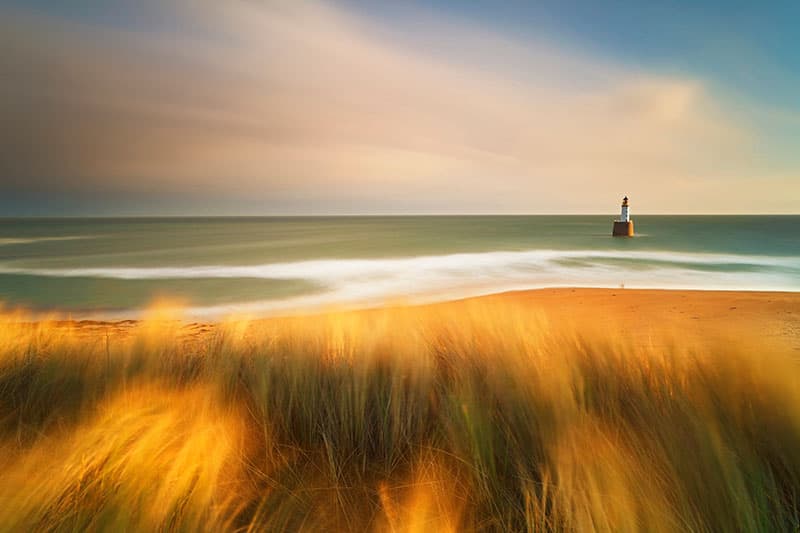Photo Insight bringing you essential expert advice every week
 Fortunato Gatto is a landscape and travel photographer who has extensively photographed the coast and countryside of Scotland, as well as Iceland, Canada, England and the Alps. He won a Specially Commended award in the 2012 Veolia Wildlife Photographer of the Year competition
Fortunato Gatto is a landscape and travel photographer who has extensively photographed the coast and countryside of Scotland, as well as Iceland, Canada, England and the Alps. He won a Specially Commended award in the 2012 Veolia Wildlife Photographer of the Year competition
At Rattray Head in Aberdeenshire, Fortunato Gatto battled 80mph winds to achieve his vision of a storm photograph. He explains his method
This image was taken at Rattray Head in Aberdeenshire, at the beginning of December 2011 during a particularly stormy day. A strong wind was blowing on the sand dunes and creating some very interesting effects. The wind-blown grass looked like flames of gold as it was illuminated by the rays of the sun. I wanted to create an ethereal mood, a kind of abstraction of the landscape.
Dynamism was the element I was looking for more than anything else, and this wouldn’t have been present without the movement caused by the wind. This is why it’s essential to check the weather conditions prior to going out shooting. While there is no bad weather for taking pictures (unless it rains horizontally and the winds reach 200mph), there are certain climates that are suitable for creating a certain mood. I like to associate climatic conditions with specific feelings – fog can represent mystery, while white snow can represent something delicate. A storm is more exciting.
The idea of dynamism is also why I chose to include the lighthouse in the frame, as it provides a static element that emphasises the movement of everything else. The lighthouse also gives the image a sense of scale, allowing the viewer to understand the size of the landscape and the proportions involved.
I used a Canon EOS 5D Mark II for this image. It’s a really good camera in terms of low ISO image quality, colour and functionality. I used a Zeiss 21mm lens, which recently replaced my old Canon 17-40mm optic, and I must say that in terms of quality there is no comparison. The 21mm is a good compromise for people like me who don’t mind an extremely short focal length and who, at the same time, want that wideangle view. I love the warm colours it produces, and its tendency to strengthen the reds in a scene. Also, its micro-contrast enables me to get a very detailed image, giving an almost three-dimensional touch that other lenses don’t provide.
I also used a couple of Lee filters for this image – a 0.6 hard ND grad and the Big Stopper, a 10-stop ND filter. This shot was a 150sec exposure, taken with an aperture of f/8; I usually manage my focus and exposure before mounting the Big Stopper because it’s practically impossible to see anything through a 10-stop ND filter once it’s positioned in front of the lens. Calculating the exposure wasn’t too hard for this image – the difficulty came from the 70-80mph winds! I had to ensure my tripod was stable by anchoring my backpack to the tripod head.

I’m pretty meticulous while preparing for a shoot, because for me it is absolutely essential to obtain the best results possible in the field, in-camera. Not only do I find this mode of execution more satisfactory, but it also results in an image that is more ‘workable’ in post-production. This image did not require a lot of post-production work, although I did have to correct the colour temperature by adding warmth, as the Big Stopper has a well-known blue cast.
I base my exposure calculations on the official scale provided by Lee Filters, which is a very useful tool, although I do have to take my own experience into consideration too. For instance, I’ve found that the Big Stopper is in reality closer to 11 stops than 10, and this makes a big difference when you need a long exposure – an extra stop can turn a 150sec exposure into a 300sec one.
With this kind of exposure, you don’t want to just leave the camera on bulb mode. If the light changes during the exposure – for instance, the sun being out when you open the shutter but covered by clouds before you finish – it’s a good idea to vary your settings to compensate. Experience is a key factor in knowing when to do this. For this picture, I had to change shutter speed on the go. I’d originally calculated an exposure of 220secs, but the intensity of the sun increased as I was shooting so I decided to stop the exposure before it was due, to avoid burning out the highlights to an irrecoverable degree. Experience is important in photography – being methodical and careful allows you to automate processes that can take more time than a brief light condition will allow for. However, when you are willing to improve, every error is a discovery.
Fortunato Gatto was talking to Jon Stapley
You can see more of Fortunato’s images at www.fortunatophotography.com








